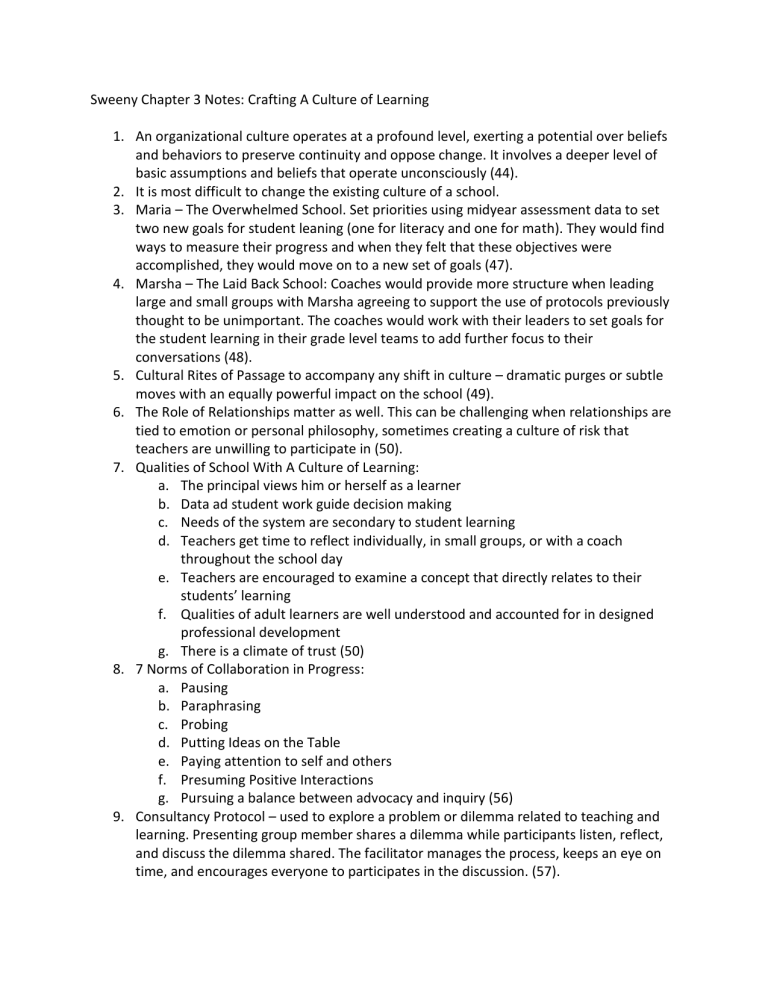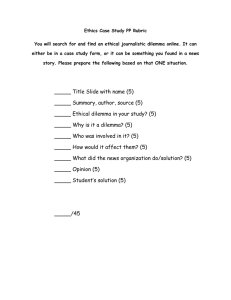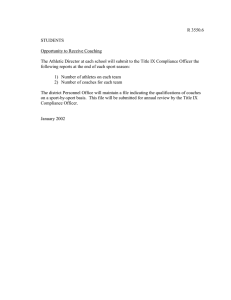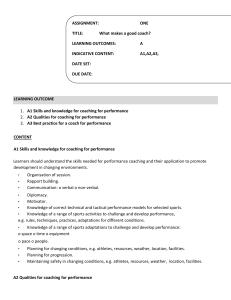
Sweeny Chapter 3 Notes: Crafting A Culture of Learning 1. An organizational culture operates at a profound level, exerting a potential over beliefs and behaviors to preserve continuity and oppose change. It involves a deeper level of basic assumptions and beliefs that operate unconsciously (44). 2. It is most difficult to change the existing culture of a school. 3. Maria – The Overwhelmed School. Set priorities using midyear assessment data to set two new goals for student leaning (one for literacy and one for math). They would find ways to measure their progress and when they felt that these objectives were accomplished, they would move on to a new set of goals (47). 4. Marsha – The Laid Back School: Coaches would provide more structure when leading large and small groups with Marsha agreeing to support the use of protocols previously thought to be unimportant. The coaches would work with their leaders to set goals for the student learning in their grade level teams to add further focus to their conversations (48). 5. Cultural Rites of Passage to accompany any shift in culture – dramatic purges or subtle moves with an equally powerful impact on the school (49). 6. The Role of Relationships matter as well. This can be challenging when relationships are tied to emotion or personal philosophy, sometimes creating a culture of risk that teachers are unwilling to participate in (50). 7. Qualities of School With A Culture of Learning: a. The principal views him or herself as a learner b. Data ad student work guide decision making c. Needs of the system are secondary to student learning d. Teachers get time to reflect individually, in small groups, or with a coach throughout the school day e. Teachers are encouraged to examine a concept that directly relates to their students’ learning f. Qualities of adult learners are well understood and accounted for in designed professional development g. There is a climate of trust (50) 8. 7 Norms of Collaboration in Progress: a. Pausing b. Paraphrasing c. Probing d. Putting Ideas on the Table e. Paying attention to self and others f. Presuming Positive Interactions g. Pursuing a balance between advocacy and inquiry (56) 9. Consultancy Protocol – used to explore a problem or dilemma related to teaching and learning. Presenting group member shares a dilemma while participants listen, reflect, and discuss the dilemma shared. The facilitator manages the process, keeps an eye on time, and encourages everyone to participates in the discussion. (57). 10. Assessing School Culture through benchmarks that focus on holding each other accountable, aligned and focused professional development, collaboration amogsnt the principal, teachers and coach on a consistent basis, and the time/resources to engage in learning. (58) Chapter 4: Data and Student-Centered Coaching 1. Why Use Data? – The teacher acquires data to see what students have learned, examines the data to assess strengths and weaknesses, and then tailors what and how she teaches based on that so students learn more. (64) 2. Data-Gap – Separates the data that surrounds teachers on a daily basis from how (or whether) they actually use it. Most often due to an overabundance of data, lack of systems to analyze it, or limited experience (64). 3. Data- Driven Coaching Conversations: Identify key findings from relevant assessment data, Look to the standards and curriculum to determine a focus for future instruction, and reassess student learning on a regular basis to determine if instruction is meeting their needs (66). 4. It is important for all curriculum and assessments to be built upon standards – a core set of instructional practices that ensure the use of data on a daily basis. Teachers complete and turn in lesson plans, coding the instruction based on whether the standard is something the students will be exposed to or will master (70) 5. Professional Development is tied to data and assessment. 6. The Work has been done by teachers and not “to” teachers 7. Sorting for differentiation helps to teacher to recognize patterns and trends related to student learning. Make three piles of work for students that share similar attributes. (72)




